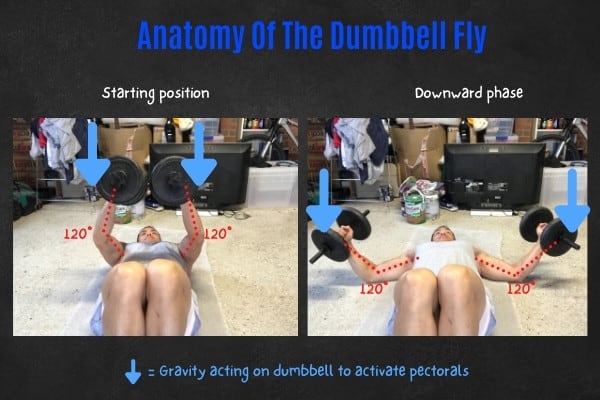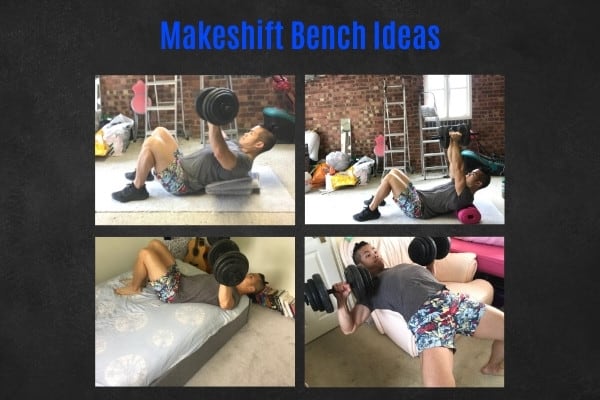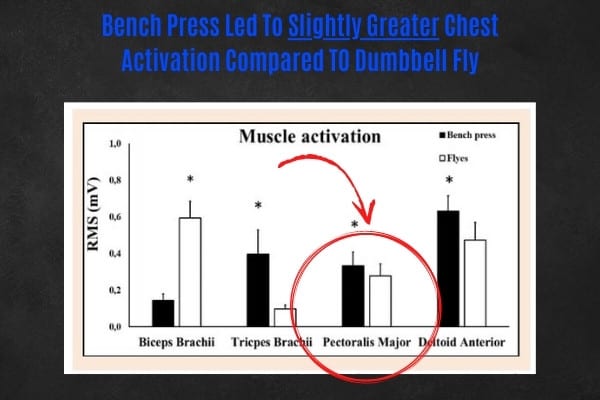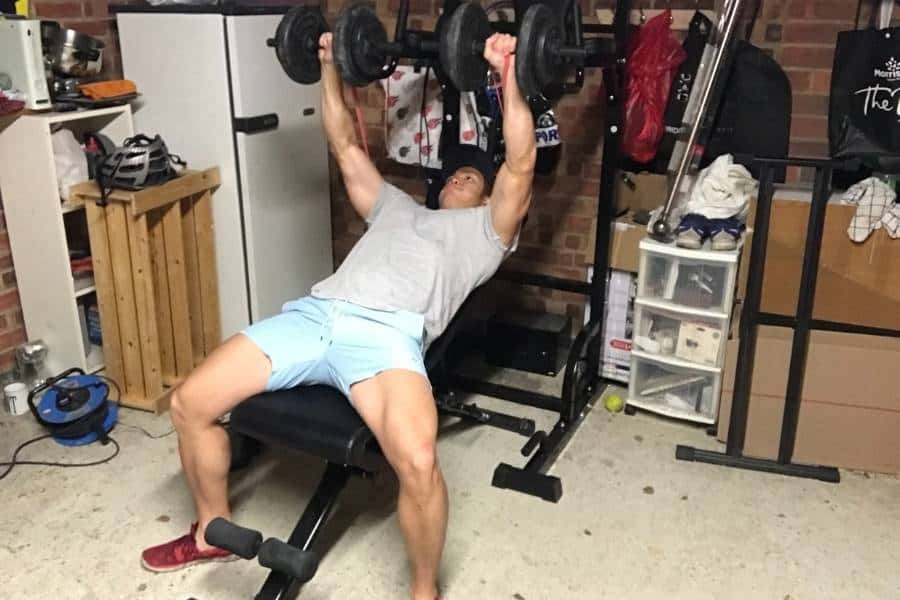The dumbbell fly is a great exercise to fix a stubborn chest. But what if you don’t have a weight bench? No problem! Today, I’ll explain how you can do dumbbell flyes without a bench and whether or not it can still be effective.
In general, a bench is not essential to do dumbbell flyes. This exercise requires the arms to horizontally adduct along the torso midline. The same movement can be replicated by lying on the floor, an exercise ball, or a makeshift bench.
I still remember my beginner days of training.
Building a killer chest was on the top of my agenda.
The problem?
I didn’t have the space or cash for a weight bench…
This forced me to research and try different ways to build the chest with dumbbells but no bench.
And that’s exactly what I’ll be sharing with you today.
Let’s get started.
How To Do Dumbbell Flyes Without A Bench
First, let’s break down the movement pattern of the dumbbell chest fly into its basic components:

The starting position has you holding the dumbbells above the chest with a 120° bend in the elbows.
From the starting position, you lower the dumbbells by arcing the arms outwards whilst maintaining the elbow bend.
Finally, you bring the dumbbells back up by arcing the arms inwards.
As gravity pulls the weight of your dumbbells downwards, it creates resistance against the pectoral muscles.
And as a result, your chest muscles are stimulated for growth!
Why you don’t need a bench to do dumbbell flyes.
Now you understand the principle behind the movement, it becomes clear why a bench is not essential to do dumbbell flyes.
Whilst a bench could make the exercise more comfortable for beginners, the bench itself is not required to complete the movement.
As an alternative to a bench, you could just lay on the floor or an exercise ball instead.
Whilst the feeling can take time to adjust to, it works equally well as the bench fly.

If you’re a bit more adventurous, you could also try making your own DIY flat bench using:
- Couch footstool.
- Couch armrest.
- Cofee table.
- Stack of towels or pillows.
- Foam roller.
- Sack of sand or rice.
- Stack of books.
These items allow you to either lay your back fully or partially on the object.
And this will provide sufficient support as you perform the exercise.
Next, I’ll explain the 3 ways you can do dumbbell flyes without a bench. I’ll also share alternatives to the dumbbell fly.
Check out my other article for 15 homemade weight bench ideas!
1) Dumbbell floor flyes.
Doing dumbbell flyes on the floor is the simplest way to perform the exercise without a bench.
It’s also the safest and easiest method since there’s no risk of falling.
How to do it:
- Lay on the floor with a pair of dumbbells standing upright on either side of your body.
- Stabilise yourself by bending your knees upwards, spreading your legs slightly apart, and planting your feet on the ground.
- Grab each dumbbell with a neutral grip (palms facing towards the side of your body).
- Flex your arms at the elbows to lift the dumbbells off the ground and once they are off the ground, extend your arms to bring the dumbbells over your chest.
- Arc both dumbbells outwards as you lower them towards both sides of your body.
- Keep a 120° bend at the elbows throughout the movement to relieve pressure from the shoulders.
- Once your elbows touch the ground, arc the dumbbell upwards again.
- Actively squeeze the dumbbells together at the top of the movement.
Top tip:
Since the floor prevents your elbows from dropping beneath the torso, your range of motion (ROM) is limited.
And this reduces pectoral activation.
You can counteract this issue by reducing your lifting tempo to make the exercise harder.
I like to count 4 seconds on the downward phase and 2 seconds on the upward phase.
You can also take a 1-second pause as your transition from the downward phase into the upward phase.
2) Dumbbell chest flyes on an exercise ball.
Doing dumbbell flyes on an exercise ball is a great way to regain the ROM which is otherwise lost in the dumbbell floor fly.
However, the exercise ball variation is much harder to perform since it requires a lot of stability. This can be good for engaging your abdominals which are is necessary to stabilize your core as you go through the movement.
How to do it:
- Hold a pair of dumbbells in both hands and sit on an exercise ball.
- Roll your buttocks and lower back over the ball to bring the ball onto your upper back.
- Make a glute bridge by planting both feet onto the ground and pushing your hips upwards so that your back is flat and parallel to the ground.
- Lift the dumbbells into the starting position and follow steps 5. to 8. from “dumbbell floor flyes” (see above).
Top tip:
This exercise is inherently unstable.
So always start with lighter dumbbells and slowly work your way upwards.
A good pair of adjustable dumbbells is recommended.

I use the Powerblock Elites- they’re not the cheapest dumbbells on the market, but they do offer good value for money and are definitely one of the best dumbbells for chest training.
They go as low as 2.5lbs per dumbbell with further 2.5lb increments that take them to 50-90lbs.
This makes them ideal for progressively adding extra weight in small amounts as your chest becomes stronger.
The higher poundage settings are also great for floor presses to help you build a bigger chest without a bench.
Another tip- keep your legs as wide as possible to help stabilize yourself.
3) Dumbbell chest flyes on a makeshift bench.
As I mentioned previously, there are many household objects you can use to create a makeshift weight bench.
These are ideal to perform the dumbbell fly since they are usually sturdy enough to accommodate your body weight plus the weight of any dumbbell.
How to do it:
- Create your makeshift weight bench and make sure it’s sturdy.
- If the makeshift bench accommodates your entire back, then treat it as a normal bench and follow the steps from “dumbell floor flyes”.
- If the makeshift bench only accommodates half your back, then you’ll need to do a glute bridge and follow steps from “dumbbell chest flyes on an exercise ball”.
Top tip:
Some makeshift bench methods such as the towel, pillow, foam roller, and sack of sand allow you to create an incline angle too.
To do this, simply slide yourself downwards and have the bench sit on your upper back rather than the lower back.
This allows you to turn the dumbbell fly into an incline dumbbell fly to target the upper chest!
You can check out my other article for more ways to create an incline bench at home!
4) Dumbbell fly alternatives.
Don’t forget there are other dumbbell chest exercises, besides the fly, that you can do without a bench.
Here are my favorite dumbbell exercises to help you build a chest without a bench:
- Dumbbell floor press.
- Decline dumbbell floor press.
- Standing upward chest fly.
- Dumbbell pullover on the floor.
- Dumbbell crossover.
I’ve personally used all of these to help me build my chest, so I know they work.
Certain exercises like the floor press require more weight to challenge your pecs compared to other exercises like the fly.
So a pair of dumbbells that allow heavy AND light lifting will allow you to take full advantage of all these exercises.
The Powerblock Elites are ideal since they go from 2.5lbs all the way to 90lbs per dumbbell with the stage 2 and stage 3 addon kits
Dumbbell Flyes On The Floor Vs Bench: Which Is More Effective?
Is there even a difference between doing dumbbell flyes on the floor vs doing them on a bench?
In terms of biomechanics, there isn’t much difference at all.
The motion should remain the same regardless of which dumbbell fly variation you do.
Be careful with your elbows during the fly!
The only major difference between the floor and bench fly is that you can’t drop the elbows below the torso during the floor fly.
This restricts the overall ROM, but many experts argue that this is a good thing.
“I prefer the floor fly variation where you have the floor to prevent unwanted joint stress in the shoulders”
Jeff Cavaliere, C.S.C.S, Athlean-X
A major mistake that people make when doing the dumbbell fly is allowing the elbows to drop too far down.
When this happens, you put a lot of stress on your shoulders.
By doing the floor fly, your elbows are physically prevented from dropping unnecessarily low.
And this will help to prevent injury as well as make the movement easier to perform.
Therefore, my opinion is that the dumbbell floor fly is actually more effective (when done right) than the dumbbell bench fly.
The floor fly is perfectly effective!
Not only is the floor fly much safer than the bench fly, but they both work equally well for building the pecs.
“My clients, ranging from top powerlifters to more aesthetic-minded enthusiasts, have had excellent results using the floor pause dumbbell fly.”
Josh Bryant, C.S.C.S, Powerlifter.
As I mentioned previously, you can mitigate the limitations of a reduced ROM by simply decreasing the lifting tempo and including a pause in the movement.
This will make the dumbbell floor fly more effective, significantly increase pectoral activation, and help you build a bigger chest!
Dumbbell Fly Vs Bench Press: Which Builds More Muscle?
The dumbbell fly and bench press are arguably the two most popular exercises to train the chest with.
But which one builds more muscle?
In general, the bench press produces more muscle development than the dumbbell fly. This is supported by evidence that the barbell bench press elicits a greater pectoral activation compared to the dumbbell fly, and muscle activation correlates with muscle development.
The details can be found in this 2020 study.

You can see that pectoral activation is slightly higher during the barbell bench press, compared to the dumbbell fly.
This would suggest that the bench press builds more muscle.
However, the authors didn’t replicate the same experiment with the dumbbell bench press (which most would agree on leads to greater pectoral activation compared to the barbell bench press).
To my current knowledge, no experiments have been conducted to compare pectoral activation between the dumbbell fly and bench press.
If you know of one, please let me know in the comments!
Conclusion
I’ve explained 3 ways you can do dumbbell flyes without a bench.
I’ve also shared my opinions, and that of two experts (Jeff Cavaliere and Josh Bryant), regarding the effectiveness of the dumbbell floor fly.
It’s safe to say that we all agree that you can do flyes effectively on the floor instead of a bench.
In fact, the floor fly can be very effective at facilitating chest growth when performed correctly.
That being said, if you are serious about building a killer chest, having access to a weight bench will always be better than having no weight bench.
You’ll need a weight bench, not to just do chest flyes, but to bench press heavy loads for maximum chest activation.

The Flybird adjustable bench is perfect for beginner/intermediate home gyms. It’s cheap, foldable, and the 7x angle adjustments allow you to hit all pectoral regions at home.
Have you tried the dumbbell flor fly?
Let me know in the comments!
You may also be interested in the downloadable Kalibre Blueprint PDF which details exactly how I gained 40lbs of lean muscle (it’s 100% free!). It gives the exact exercises and nutrition I used to go from skinny to ripped!
Thanks for reading guys!
Peace Out,
Kal
(Biochemistry BSc, Biomedical Sciences MSc, Ex-Skinny Guy)


